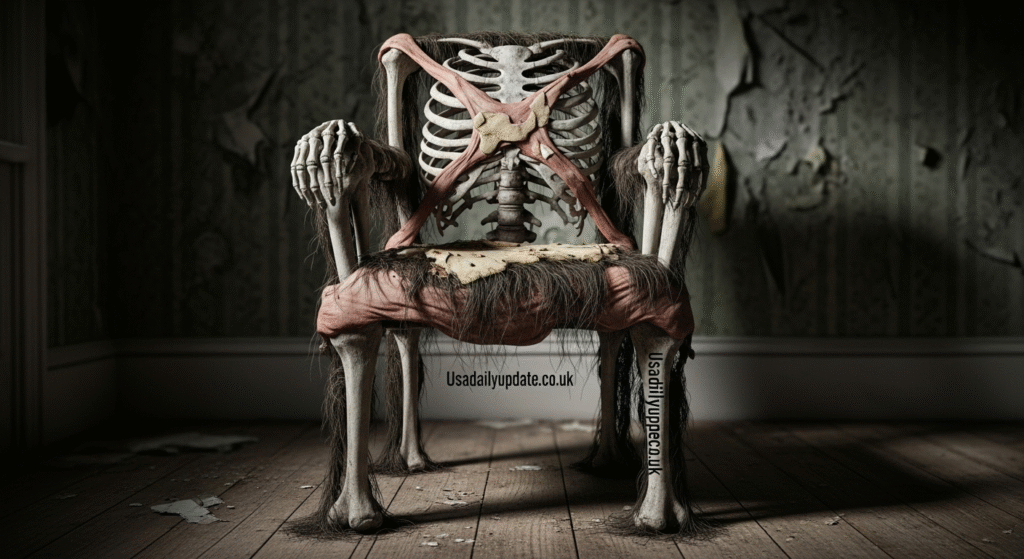Ed Gein Chair: Disturbing Truth Behind Infamous Furniture

Introduction
When police entered Ed Gein’s Wisconsin farmhouse in 1957, they weren’t prepared for what they’d find. Among the horrifying discoveries was furniture that would become infamous in true crime history. The Ed Gein chair, along with other handmade items, revealed a level of depravity that shocked even seasoned investigators.
You’ve probably heard whispers about Ed Gein’s crimes. His story inspired countless horror movies, from “Psycho” to “The Texas Chain Saw Massacre.” But the real details are far more disturbing than any Hollywood script. The furniture he created from human remains represents one of the most macabre chapters in American criminal history.
In this article, we’ll explore the truth behind the Ed Gein chair and other items found in his home. We’ll examine what drove him to create these objects, how they were discovered, and why this case continues to fascinate people decades later.
Who Was Ed Gein?
Before we discuss the Ed Gein chair, you need to understand the man behind these disturbing creations.
Edward Theodore Gein was born in 1906 in La Crosse County, Wisconsin. He grew up on a small farm in Plainfield with his domineering mother, Augusta, his alcoholic father, and his older brother Henry.
Augusta Gein was a religious fanatic who despised the modern world. She preached to her sons about sin and the evils of women. She isolated the family from the community and instilled in Ed a toxic mixture of devotion and fear.
After his mother died in 1945, Ed became increasingly isolated. He lived alone in the family farmhouse, taking odd jobs around Plainfield. Neighbors considered him strange but harmless. They had no idea what was happening inside his home.
Between 1954 and 1957, Gein committed at least two murders. But his crimes went far beyond killing. He robbed graves from local cemeteries, taking bodies back to his farmhouse. There, he would dismember them and use the parts for various purposes.
The Discovery That Shocked America
On November 16, 1957, hardware store owner Bernice Worden disappeared from her shop in Plainfield. Her son, a deputy sheriff, suspected Ed Gein. He’d been the last customer seen at the store.
When police entered Gein’s farmhouse that evening, they made a discovery that would haunt them forever. Bernice Worden’s headless body hung from the ceiling, dressed like a deer carcass. But that was just the beginning.
As investigators searched the house, they found room after room filled with human remains and items made from body parts. The place was a literal house of horrors. Many rooms were boarded up, cluttered with garbage, old newspapers, and agricultural equipment mixed with human remains.
The kitchen and the small bedroom Ed used were relatively normal. But everywhere else revealed his gruesome activities.
The Infamous Ed Gein Chair and Other Furniture
The Ed Gein chair is perhaps the most talked-about piece of furniture from his collection. While multiple chairs were found in the house, certain ones had seats upholstered with human skin.
Gein had carefully tanned and preserved the skin, then used it to cover chair seats. To investigators, these chairs looked relatively normal at first glance. The human skin seats blended with the worn, shabby furniture that filled the house.
But the Ed Gein chair wasn’t the only disturbing furniture piece. Investigators also found:
- A wastebasket made from human skin – Gein had crafted it with the same “leather” he used for other items
- Lampshades covered with human flesh – These became particularly infamous in popular culture
- A shoebox containing preserved human organs – Kept like twisted souvenirs
- Skulls used as bowls – He’d sawed off the tops to create crude containers
Gein also created numerous non-furniture items from human remains. He made masks from facial skin, a corset from a female torso, and leggings from human leg skin. He kept lips attached to a drawstring for a window shade pull. He stored body parts in his kitchen, including human heads in paper bags and organs in the refrigerator.
The inventory list from his house reads like a nightmare. Yet Gein lived among these items daily, treating them as normal household objects.
Why Did Ed Gein Create These Items?
Understanding why Gein created the Ed Gein chair and similar objects requires examining his psychology and motivations.
His Mother’s Influence
Augusta Gein’s death devastated Ed. She’d been the center of his world, despite her abusive control. Some psychologists believe he tried to preserve or recreate her through his crimes.
Gein confessed to wearing some of the items he created, including the skin masks and female body suits. He said he wanted to “become” his mother or other women. This suggests a complex identity disturbance rooted in his childhood trauma.
Necrophilia and Obsession
Gein exhibited necrophilic tendencies, though accounts differ on the extent of his activities. He was fascinated with death, anatomy, and the female body—subjects his mother had taught him were sinful and forbidden.
By creating furniture and clothing from human remains, he maintained constant contact with the dead. The Ed Gein chair and other items let him literally surround himself with what obsessed him.
Mental Illness
Gein was eventually diagnosed with schizophrenia and found mentally incompetent to stand trial initially. After treatment, he was tried and found not guilty by reason of insanity for one murder.
His mental illness likely played a significant role in his crimes. He seemed unable to distinguish between normal behavior and his grotesque actions. To him, the Ed Gein chair was just furniture.
The Trial and Aftermath
Gein’s case became a media sensation. Reporters descended on tiny Plainfield, Wisconsin, transforming it from an unknown farming community into synonymous with horror.
In 1968, after being deemed competent, Gein stood trial for the murder of Bernice Worden. He was found not guilty by reason of insanity and sent to Central State Hospital for the Criminally Insane.
He never stood trial for his other suspected murder or for grave robbing. Authorities focused on the Worden case because it had the strongest evidence.
What Happened to the Evidence?
You might wonder what became of the Ed Gein chair and other items found in his house. The physical evidence was essential for trial, but afterward, most items were destroyed.
The Waushara County Sheriff’s Department kept some items for years. However, there was always morbid interest from collectors and curiosity seekers. This created ethical and practical problems for law enforcement.
In March 1958, many of Gein’s belongings were sold at public auction. People from across the country came to bid. The crowd was so large that additional security was needed.
However, the most gruesome items—including the Ed Gein chair and anything made from human remains—were not sold. These were eventually incinerated by court order. Officials wanted to prevent them from becoming macabre souvenirs or inspiring copycat criminals.
Gein’s house itself also met a fiery end. Shortly before the auction, someone set it ablaze. It burned to the ground, destroying whatever remained inside. The fire marshal ruled it arson, but no one was ever charged.

The Cultural Impact of Ed Gein’s Crimes
The Ed Gein chair and his other crimes have cast a long shadow over American popular culture. His story has influenced countless books, movies, and television shows.
Horror Movie Inspiration
Robert Bloch wrote “Psycho” shortly after Gein’s arrest, directly inspired by the case. Alfred Hitchcock adapted it into his famous 1960 film. Norman Bates, with his mother obsession and isolated house, clearly echoes Gein.
“The Texas Chain Saw Massacre” (1974) drew heavily from Gein’s crimes. The furniture made from bones and skin, the isolated farmhouse, and the disturbed killer all reference the real case.
“The Silence of the Lambs” features Buffalo Bill, a killer who skins his victims. Author Thomas Harris acknowledged Gein as inspiration for this character.
True Crime Fascination
The Ed Gein case helped establish the modern true crime genre. His crimes were so extreme they captured public imagination in unprecedented ways.
Before Gein, most Americans didn’t think about serial killers or psychopathic murderers. His case, along with others that followed, created awareness of these offenders. It also sparked public fascination with understanding what makes such people commit horrific acts.
Museums and exhibits occasionally display information about Gein (though never the actual items). True crime enthusiasts visit Plainfield to see where it all happened, though little remains except the cemetery where he’s buried.
The Psychology Behind the Fascination
Why do people remain fascinated with the Ed Gein chair and his crimes more than 65 years later? What drives this continued interest in something so disturbing?
Morbid Curiosity
Humans have a natural, if uncomfortable, curiosity about death and the macabre. We want to understand evil, even when it repels us. Gein’s crimes are so extreme they almost seem unreal, which paradoxically makes them more fascinating.
The Ed Gein chair represents something tangible from these incomprehensible acts. It’s easier to grasp the horror of a piece of furniture than to fully comprehend the psychological devastation that created it.
Understanding Evil
Many people study cases like Gein’s to understand how someone becomes capable of such acts. Are people born evil, or do circumstances create them? Gein’s troubled childhood and mental illness provide partial answers, but mysteries remain.
Distance and Safety
Most people encounter the Ed Gein story from a safe distance. We can explore the horror without danger. This allows us to experience fear and disgust in a controlled way, similar to watching a horror movie.
Lessons from the Ed Gein Case
Beyond the horror, the Ed Gein case taught law enforcement and mental health professionals important lessons.
Warning Signs
Gein displayed numerous warning signs that went unnoticed or ignored. His extreme social isolation, his mother’s psychological abuse, and his strange behavior were all red flags. Today, we’re better equipped to recognize when someone needs intervention, though certainly not perfect.
Mental Health Treatment
The case highlighted the need for better mental health services. Gein likely suffered from severe mental illness for years before committing his crimes. With proper treatment, some of his actions might have been prevented.
Evidence Preservation
The destruction of the Ed Gein chair and other evidence was controversial. While understandable from an ethical standpoint, it eliminated valuable material for future psychological and criminological study. Modern protocols try to balance these competing interests more carefully.
Ed Gein’s Death and Legacy
Ed Gein spent the rest of his life in mental institutions. By most accounts, he was a model patient—quiet, cooperative, and seemingly unaware of why his actions had been wrong.
He died on July 26, 1984, at the Mendota Mental Health Institute in Madison, Wisconsin. He was 77 years old. The cause of death was respiratory failure due to cancer and heart disease.
Gein was buried in Plainfield Cemetery, ironically near some of the graves he’d robbed decades earlier. His grave initially had a headstone, but souvenir hunters repeatedly vandalized it. Pieces were chipped off so often that eventually only a bare stone remained. In 2000, someone stole the entire headstone. It was later recovered but is now stored in an undisclosed location.

Visiting Plainfield Today
If you’re interested in true crime history, you might wonder what remains in Plainfield, Wisconsin. The truth is, not much.
The Gein farmhouse burned down in 1958, and the property was sold. The new owners wanted nothing to do with its history. Today, the land is privately owned, and nothing marks the site.
The hardware store where Bernice Worden was abducted no longer exists. Most buildings from that era have been replaced or repurposed.
Plainfield itself is a small, quiet town trying to move past its dark history. Residents generally don’t appreciate curiosity seekers. There are no museums, tours, or markers commemorating Gein.
The cemetery where Gein is buried is accessible to the public, but out of respect for other families, the location of his grave isn’t officially disclosed.
The Ethics of True Crime Interest
The Ed Gein chair and his crimes raise important ethical questions about our consumption of true crime content.
Is it wrong to be interested in such horrific acts? Does talking about these crimes honor or dishonor the victims?
There’s no simple answer. True crime interest can be educational and help us understand dangerous individuals. It can lead to better prevention and treatment. But it can also veer into exploitation and glorification of killers.
The key is approaching these topics with respect for victims and their families. Bernice Worden and the people whose graves Gein robbed were real individuals with loved ones. They deserve to be remembered as more than just Gein’s victims.
Conclusion
The Ed Gein chair represents one of the most disturbing artifacts in American criminal history. It’s a physical manifestation of extreme mental illness, childhood trauma, and profound disturbance. While the chair itself and other items have long since been destroyed, their legacy continues.
Ed Gein’s crimes shocked the nation and changed how we think about serial killers and psychopathic behavior. They inspired countless works of fiction and helped establish the true crime genre. But beneath the horror movie references and cultural impact are real victims and a deeply troubled man who needed help long before he committed his atrocities.
When you hear about the Ed Gein chair or see references to his crimes in movies and shows, remember the human cost behind the horror. These weren’t just scary stories—they were real tragedies that devastated a community and ended innocent lives.
What do you think drives our continued fascination with cases like Ed Gein’s? Is it healthy curiosity or something darker? The answer might tell us something important about ourselves.
Frequently Asked Questions
What exactly was the Ed Gein chair made of?
The Ed Gein chair had seats upholstered with human skin that Gein had tanned and preserved. He treated the skin like leather, using it to cover ordinary chair frames. Multiple chairs in his house had these modifications, though from a distance they looked like normal furniture.
Are any of Ed Gein’s items still in existence?
No, all items made from human remains, including the Ed Gein chair, were destroyed by court order. They were incinerated to prevent them from becoming morbid collectibles. Some non-gruesome personal items were auctioned in 1958, but these were ordinary household goods.
How many people did Ed Gein kill?
Gein was convicted of one murder (Bernice Worden) and confessed to killing another woman (Mary Hogan) in 1954. However, he robbed numerous graves and used those remains for most of his creations. He was technically responsible for two murders but desecrated many more bodies.
Was Ed Gein the inspiration for Leatherface?
Yes, Ed Gein was one of the primary inspirations for Leatherface in “The Texas Chain Saw Massacre.” The character’s practice of making masks and furniture from human skin directly references Gein’s crimes. However, Leatherface is more violent and aggressive than Gein ever was in real life.
Why didn’t anyone notice what Ed Gein was doing?
Gein lived alone on an isolated farm and kept to himself. He boarded up most of his house, so visitors only saw one or two relatively normal rooms. Neighbors thought he was odd but harmless. Small-town trust and his quiet demeanor helped him avoid suspicion for years.
What happened to Ed Gein’s victims’ families?
The families of Mary Hogan and Bernice Worden were devastated by the crimes and the subsequent media attention. The families of those whose graves were robbed also suffered greatly. Many Plainfield residents were traumatized by learning that someone they’d known could commit such acts.
Where is Ed Gein buried?
Ed Gein is buried in Plainfield Cemetery in Wisconsin, near his mother and brother. His grave initially had a headstone, but it was repeatedly vandalized and eventually stolen in 2000. The recovered headstone is now in secure storage. The grave location isn’t officially marked.
Did Ed Gein show remorse for his crimes?
Accounts vary, but generally Gein seemed more confused than remorseful. He appeared not to fully understand why his actions were wrong. His mental illness likely prevented him from grasping the moral implications of what he’d done. In the institution, he was described as a quiet, cooperative patient.
How accurate are the movies based on Ed Gein?
Movies inspired by Gein take significant creative liberties. Norman Bates, Leatherface, and Buffalo Bill are fictional characters who incorporate elements of Gein’s crimes but aren’t biographical. The real Ed Gein was a lonely, disturbed man who never committed the violent murders depicted in these films.
What can we learn from the Ed Gein case today?
The Ed Gein case teaches us about the importance of mental health treatment, recognizing warning signs of disturbed individuals, and the lasting effects of childhood abuse. It also reminds us that evil can hide in plain sight and that communities need systems to identify and help troubled individuals before they harm others.
Also Read Usadailyupdate.co.uk

